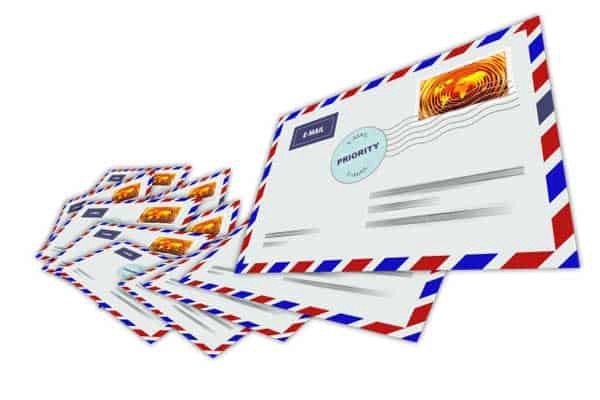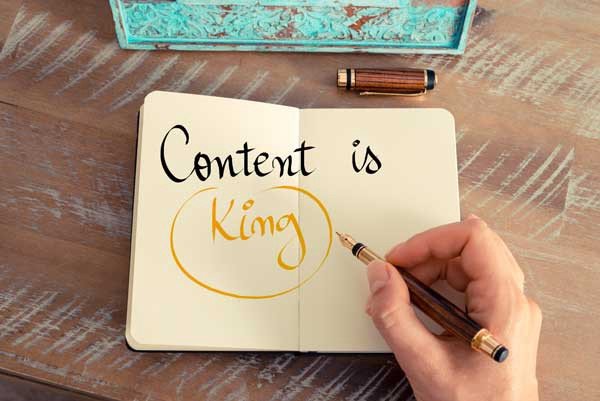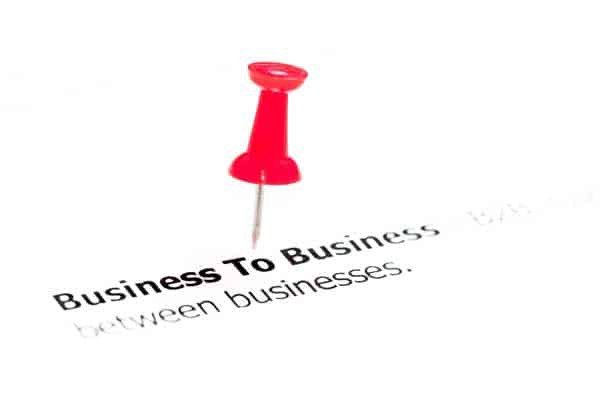Email marketing is one of the best ways to connect with customers and reach out to prospects with information that will catch their interest. It allows you to build and increase awareness around your brand and product, conduct lead generation, and begin or continue conversations with people who might be interested in your product. Additionally, email marketing is measurable. While the ultimate success metric for any type of marketing is purchase, B2B email marketing provides multiple lenses through which you can measure improvement and success as you nurture prospects along the way.

Common types of business to business email marketing include:
- Drip emails — These emails are sent out, typically as part of a larger marketing campaign, on a regular schedule (for example, monthly or quarterly). Drip emails often include content such as white papers, ebooks, and case studies. If part of an evolving message campaign, the emails are generally sent out at two to three week intervals over a quarter, working to expand your prospect’s understanding and possibly move them along the buyer’s journey.
- Emails for online and offline events — These include save-the-dates, invitations, registration reminders, and follow-ups for in-person events and things like webinars, webcasts, etc.
- Newsletters — These emails typically recur on a monthly or a bi-monthly basis. They usually contain news, product updates, or other features of interest to customers and prospects.
Regardless of which type of email you are developing, certain principles and best practices apply across the board. In the next sections, we will cover some of these best practices.

Know Your Audience and Make Sure You Reach Them
As with all other marketing work, start with getting to know your audience. An understanding of your audience will provide you with a compass to reference as you build your B2B email marketing plan. You may use these questions as guideline:
- What are your audience’s business roles? Do they belong to the c-suite? Are they in decision-making positions? Are their titles executive, president, director, manager, practitioner? Some combination of these?
- What are your audience’s key pain points? How does your product address these pain points?
- What type of content does your audience enjoy? Infographics, newsletters, case studies, ebooks, or maybe white papers? Do they prefer long-form or short-form? Do they like to read or would they rather watch a video?
- What type of wording gets your audience’s attention? Is there industry-specific vernacular that you should be using?
After you develop an understanding of your audience, you may want to segment your email lists so you can implement a targeted content approach. It’s also important to keep your lists updated. Integrate email address acquisition into your prospecting strategy, so you and your team have goals for collecting addresses during networking events and tradeshows, during inbound calls and cold calls, and on appropriate webpages.

Create Compelling Content
If you agree Content is King? Knowing what type of content to include in your email starts with knowing your audience well. After you have a good handle on your audience and the types of content they are bound to engage with, there are a few general best practices to keep in mind:
- Keep your writing professional but conversational. Introducing too much promotional or salesy language into your content can be an instant turnoff for a reader. Instead, take a conversational tone. Aim to inform rather than to sell. While your content should always strive to position your product and company as a thought leader, it should also contain information useful to your readers, whether or not they decide to purchase.
- Choose your words wisely.
- Leave out buzzwords, superlative adjectives, or other language that might leave your writing feeling overly promotional or impersonal. If, however, you found industry-specific vernacular that speaks to your audience, feel free to use it.
- Be concise.
- Avoid words, phrases, and styles that can cause your email to be treated as spam. Spam filters look for items like exclamation points, the use of all-capital letters, and words such as “free” and “act now” in the subject line.
- Create subject lines that are short and catchy. Be clear about what recipients will get by opening the email.
- Develop a clear Call To Action (CTA)
- Keep the buyer’s journey top of mind. If you can track where your recipients are in the buyer’s journey, you can structure your efforts so you’re providing the right people with the right information at the right time. For instance, if someone is just hearing about your company for the first time, a webinar on a specific facet of your product may not lead to much engagement. Instead, a customer case study, infographic, or data sheet might be more appropriate. On the other hand, if recipients have already investigated your product and are further along in the sales funnel, you want to provide content that speaks to their industry and enables them to more easily build a case for your product to their organization’s decision-makers.
- Plan to use colorful, engaging imagery to break up text when appropriate. If you include a video asset, insert an image and a CTA, such as “Watch Now.”

Plan Your Email Template
Once you know your audience, it’s time to make decisions about your email templates.
It’s important to note that your emails communicate messages on multiple levels. At the most basic level, your copy, from subject line to signature, is communicating straightforward information to your audience. Taking a few steps back, everything in your email, from the font you use to the images you include (or don’t include), sends subtle communications to your recipients about your brand.
As you develop your email templates, here are a few things to consider for email template:
- HTML or plain text. Will your emails be plain text, HTML, or a combination of both? Because it is less likely to trigger spam filters and is universally readable by all email clients, plain text is preferable for drip emails. For newsletters or event invitations, on the other hand, using HTML allows you to create more aesthetically complex designs that are bound to grab your readers’ attention.
- Copy arrangement. Time is a sparse commodity for readers today. So make it easy for them. Focus on writing brief, punchy, digestible copy. This means short sentences, short paragraphs, and wherever possible, bullet points or lists.
- Image-to-text ratio. In some cases, like drip campaigns, images might not be necessary. With other types of emails, like newsletters or event invitations, images could serve as great engagement tools. Paying attention to when images serve to engage and when they serve to obscure your messaging will go a long way.
- CAN-SPAM Act regulations. Your template should incorporate elements necessary for complying with the CAN-SPAM Act, such as a valid physical postal address and a clear way to unsubscribe.
- Contact information. You may want to include multiple ways for your prospects to contact you, such as a campaign-specific phone number, email address, or webpage.
- CTAs. Your email will most likely contain a CTA. You may want to decide on a special CTA font or button type. You may also want to think about its placement.
- Social media icons, widgets, and links. Include icons, widgets, or links to your company’s social media properties, such as Facebook, Twitter, and LinkedIn.
- Testing. Different email clients, browsers, and devices (smartphones, tablets, and computers) respond differently to different types of formatting. Test for potential formatting issues across a variety of email clients, browsers, and devices.
Include a Call to Action (CTA)
All emails should contain a CTA, a next step your reader can take to follow up or engage with you. A CTA might be something simple, like a link to free online content. Then again, it might be something more complicated, like a reminder to register for an event or a button to request quotes, information, demonstrations, or free trials for your product. To motivate your prospects to act on some CTAs, you may want to even offer an incentive.
Whatever your CTA is, its placement in your email is critical. Your readers must be able to find it quickly and know where it will lead them. To accomplish this, place your CTA close to either the top or bottom of the email. Use a different font, button style, or hyperlinked text to help your CTA stand out. Additionally, make sure the CTA is clear, telling readers what will happen, what they will receive, or what their next step will be.
Here are a few examples:
- Schedule a demo
- Register for the webinar
- Get the ebook
Make Your Results Measurable, follow by Test, Measure, and Optimize
Measuring the results of email marketing endeavors gives you insight into what you did well and where you can improve.
To make sure you’re tracking results tied to your campaign, you may want to develop a campaign-specific landing page, use tracking links, or have a distinct campaign reply-to email address or phone number.
Marketing automation tools that can help you track the effectiveness of your email marketing efforts include Marketo, Oracle Eloqua, Salesforce Pardot, Mailingboss and HubSpot. Though each of these tools provides slightly different capabilities, they all enable you to track useful metrics. (You may have goals set already, but if you don’t, you can also use these metrics to help set future goals.)
Here are some common metrics to track your B2B email marketing campaign:
- Open rate — This metric tracks the number of times your email was opened in recipients’ inboxes.
- Time spent on email (email open time) — Some metrics track the amount of time readers spend with your email. For instance, a reader may open your email, spend two seconds looking at it, and move on. Then again, a reader may spend 10 seconds or more actually reading your email. Knowing how much time a reader spends with your email can help you adjust your email strategy for future campaigns.
- Click-through rate — This takes you a step deeper into metrics than the open rate. Your readers may be opening your email but never clicking links or the CTA. The click-through rate tells you how many readers clicked a specific link in your email in ratio to how many just opened the email.
- Time spent on landing page — Someone may click a link, but that’s only part of the journey. You want to see if people are reading the information on your landing page. If they leave immediately, you may need to make some tweaks. Your landing page may not be delivering on the promise in your email.
- Forwards — This lets you see how often your email was forwarded by your recipients. Forwarded emails are often a sign that your content is compelling enough for your readers to want to share it out with their own networks.
If you have a large contact list, try splitting your list into two for an A/B test. Then you can send unique emails to each group to test performance. While you can test many things (subject lines, CTA language or design, messaging, and offerings), it’s best to test only one thing at a time. For instance, if you’re testing the CTA button color, don’t also change the CTA language and/or the subject line. Use your results to optimize your campaign deliverables or help shape future B2B email marketing campaigns.
Execution Plan For Your B2B Email Marketing
So now you know what is B2B email marketing, what is the next execution plan? Coming up next…